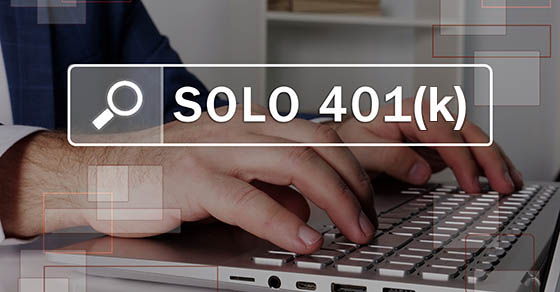It’s not only bigger companies that offer 401(k) plans. As a successful business owner with no employees you too can set up a 401(k) retirement plan.

Two ways to contribute
With a solo 401(k), the self-employed can make large annual deductible contributions to a qualified (that is, tax-advantaged) retirement account. However, this prime nest-egg-building opportunity comes with some administrative complexity.
How much can you contribute? For the 2023 tax year, you can make an “elective deferral contribution” of up to $22,500 of your net self-employment (SE) income to a solo 401(k). If you’ll be 50 or older as of December 31, 2023, you can make additional catch-up contributions up to $7,500 for a grand total of $30,000.
On top of your elective deferral contribution, an additional contribution of up to 25% (depending on your business structure) of net SE income is also permitted. This additional pay-in is called an “employer contribution,” though of course there’s no employer other than you when you’re self-employed.
For purposes of calculating the employer contribution, your net SE income isn’t reduced by your elective deferral contribution. So, for the 2023 tax year, the combined elective deferral and employer contributions can’t exceed:
- $66,000 ($73,500 with the max catch-up contribution if you qualify), or
- 100% of your net SE income.
Along with the ability to make such a large annual deductible contribution, another advantage of solo 401(k)s is that contributions are completely discretionary. When cash is tight, you can contribute a small amount or nothing. In years when cash flow is strong, you can contribute the maximum allowable amount.
In addition, you can borrow from your solo 401(k) account, assuming the plan document permits it — which you should insist on when working with a provider (usually a financial services firm). The maximum loan amount is 50% of the account balance or $50,000, whichever is less. Some other types of retirement plans don’t allow loans.
Downsides to consider
The biggest downside to a solo 401(k) is administrative complexity. You’ll encounter some substantial upfront paperwork when applying for a plan with a provider.
From there, ongoing administrative efforts will be required, including adopting a written plan document and arranging for how and when elective deferral contributions will be collected and paid into the account. Also, once your solo 401(k) account balance exceeds $250,000, you must file Form 5500-EZ with the IRS each year.
Bottom line
For a one-person business, a solo 401(k) may be a smart, tax-favored retirement plan choice as long as you have the desire and cash flow to make large contributions. This is particularly true if you’re 50 or older. Of course, there are other options to consider. Contact your Rudler, PSC advisor at 859-331-1717 to help you shop for the right retirement plan, set one up and administer it going forward.
RUDLER, PSC CPAs and Business Advisors
This week's Rudler Review is presented by Erin Mauch, Staff Accountant and Karen Daugherty, CPA.
If you would like to discuss your particular situation, contact Erin or Karen at 859-331-1717.


As part of Rudler, PSC's commitment to true proactive client partnerships, we have encouraged our professionals to specialize in their areas of interest, providing clients with specialized knowledge and strategic relationships. Be sure to receive future Rudler Reviews for advice from our experts, sign up today !